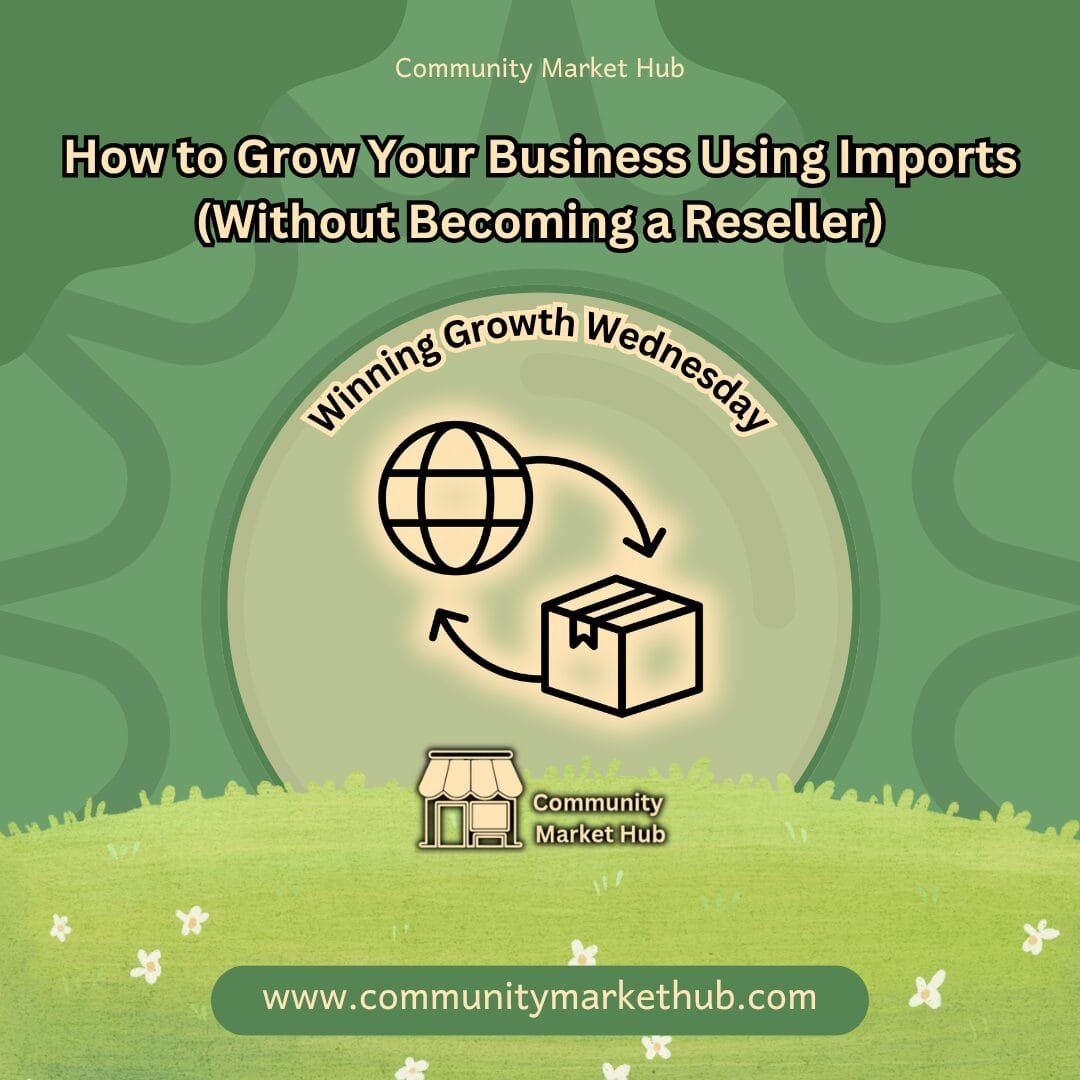No products in the cart.

How to Grow Your Business Using Imports (Without Becoming a Reseller)
When you’re just getting started, the pressure to compete with mass-market giants is real. You want to create something local. But your budget says “Temu starter pack.”
Here’s the truth: you can use imports to launch — without becoming just another reseller.
This Winning Growth Wednesday, we’re unpacking how to grow your business using imports — not by copying product listings, but by transforming basic stock into locally relevant, branded offerings that actually build your vendor reputation.
Whether it’s plain T-shirts from Shein, blank bags from AliExpress, or low-cost tools from Temu, we’ll show you how to flip them with purpose and grow a startup with local edge.
No storefront needed. Just strategy.
Table of Contents
How to Grow Your Business Using Imports
💡 Why Using Imports Isn’t Always “Cheating”
Why Using Imports Isn’t Always “Cheating”
A lot of local sellers feel ashamed to admit they started with imported stock. “I didn’t make this.” “It’s from Temu.” “People will think I’m just reselling.” Sound familiar?
But here’s the truth — using imports as startup leverage is not cheating. It’s a strategy — as long as you’re not pretending it’s something it’s not.
You can absolutely learn how to grow your business using imports if you treat them like raw materials, not retail ends.
Think of it this way:
A blank T-shirt is a canvas — not a product
A plain bag becomes a custom gift set
A cheap toy gets bundled with a learning card you made
The mistake isn’t starting with imported materials.
The mistake is reselling them as-is, with no added value, brand, or purpose.
If you’re rebranding, customising, bundling, or localising it — you’re building, not copying.
Smart Ways to Repurpose Cheap Imports Locally
Smart Ways to Repurpose Cheap Imports Locally
This is where smart sellers stand out — by flipping basic items into local, value-packed offerings that feel intentional and worth the price.
Here are some of the best tactics we’ve seen to repurpose imports the right way:
Start with plain T-shirts or hoodies from Shein or local wholesalers. Add vinyl press, embroidery, slogans in isiZulu/Xhosa/Afrikaans — or bundle with caps and tags.
Take a basic tote or laptop sleeve and add beadwork, painted logos, or package it with candles, mini cloths, or stationery.
Instead of selling a cheap peeler or toy truck, build a “new home starter pack” or “kids’ boredom box” — localised, practical, and creatively combined.
Design cover sleeves or stickers. Add motivational notes, timetables, or stickers in SA languages.
And if you’re doing that, you’re already learning how to grow your business using imports the smart, ethical way.
Legal, Ethical & Branding Boundaries to Respect
Legal, Ethical & Branding Boundaries to Respect
Repurposing imports can be powerful — but there’s a line. And if you cross it, you risk takedowns, angry buyers, or worse: a bad reputation.
Repurposing imports can be powerful — but there’s a line. And if you cross it, you risk takedowns, angry buyers, or worse: a bad reputation.
Here’s how to grow your business using imports without stepping into the danger zone:
 1. Don’t Use Fake Logos or Branding
1. Don’t Use Fake Logos or Branding
Selling items that mimic Nike, Gucci, or Apple — even if “only slightly” — can trigger copyright claims or customs seizures.
 2. Avoid Misleading Descriptions
2. Avoid Misleading Descriptions
If it’s imported and you didn’t make it — don’t say “handcrafted” or “locally made.” You can say:
“Locally rebranded”“Custom finished”“Curated with local packaging”
3. Be Honest About Origins
People are smart. If you’re upfront that you use imported stock but add value, you’ll build more trust — not less.
 4. Don’t Drop Ship Direct from Temu/Shein
4. Don’t Drop Ship Direct from Temu/Shein
That’s not a business model. That’s being a middleman with no control over delivery, quality, or service.
how to grow your business using imports responsibly?
Just follow this rule:
own the value you add, never the origin you didn’t create.
How to Transition from Imports to Local Supply
How to Transition from Imports to Local Supply
Imports can be a launchpad — but they shouldn’t be your end game.
To stay competitive, build trust, and increase your margins, you need to move from dependency to development. Here’s how to grow your business using imports — and then evolve beyond them:
 Step 1: Start with Customisation
Step 1: Start with Customisation
Use imported blanks and add value: embroidery, bundles, local packaging, or messaging.
 Step 2: Source Partial Local Components
Step 2: Source Partial Local Components
Begin swapping out parts:
Imported hoodie + local print
Imported tote + SA zip tags
Imported notebook + local sticker pack
 Step 3: Build Your Vendor Network
Step 3: Build Your Vendor Network
Join community WhatsApp groups, visit markets, or message CMH vendors to find local producers. Even small collabs can reduce your import reliance.
 Step 4: Test Fully Local Runs
Step 4: Test Fully Local Runs
Once you know what sells, test 10–20 units made locally. Price it right, tell the story, and track the feedback. This also opens your path to wholesale supply down the line.
That’s the real path if you’re learning how to grow your business using imports — start smart, then build strong.
Build Smart. Stay Local. Grow Clean.
Build Smart. Stay Local. Grow Clean.
You don’t need to start perfect. You just need to start with a plan — and with purpose. Using imports isn’t wrong. But how you use them matters more than what they are. When you add local value, support other makers, and commit to upgrading step-by-step, you’re doing more than selling — you’re building something real.
So if you’re wondering how to grow your business using imports the right way, here’s your checklist:
✅ Add local identity
✅ Be honest about origins
✅ Offer better service
✅ Upgrade gradually
✅ Stay true to your market
🔗 Supplyia on Sourcing Strategy
“Global sourcing offers cost advantage, but domestic supplies bring faster lead times, better communication, and quality control.”
Final Thought: Want Help Starting or Scaling?
📩 Chat to Arno via WhatsApp:
🌍 Or register free at:
https://communitymarkethub.com
Let’s build a community that starts smart — and grows strong 💚
Related posts
Radio Advertising South Africa: How Authentic Audio brings Brands to Life With a background in Broadcasting and Radio Advertising in... Continue reading
Peaceful Mind: Trauma Healing & Hypnotherapy with Lara Klopper It takes courage to heal — and even more courage to... Continue reading
How to Get More Sales Online (Without Ads) – The Power of Community 🧩 Want to Know How to Get... Continue reading
Best Places to Sell Products in South Africa: Top 5 Picks for 2025 📦 Best Places to Sell Products in... Continue reading
Hidden Pain Points in South African Ecommerce – 4 Vendor Killers to Fix Now 🧠 Most vendors aren’t failing because... Continue reading







Add comment